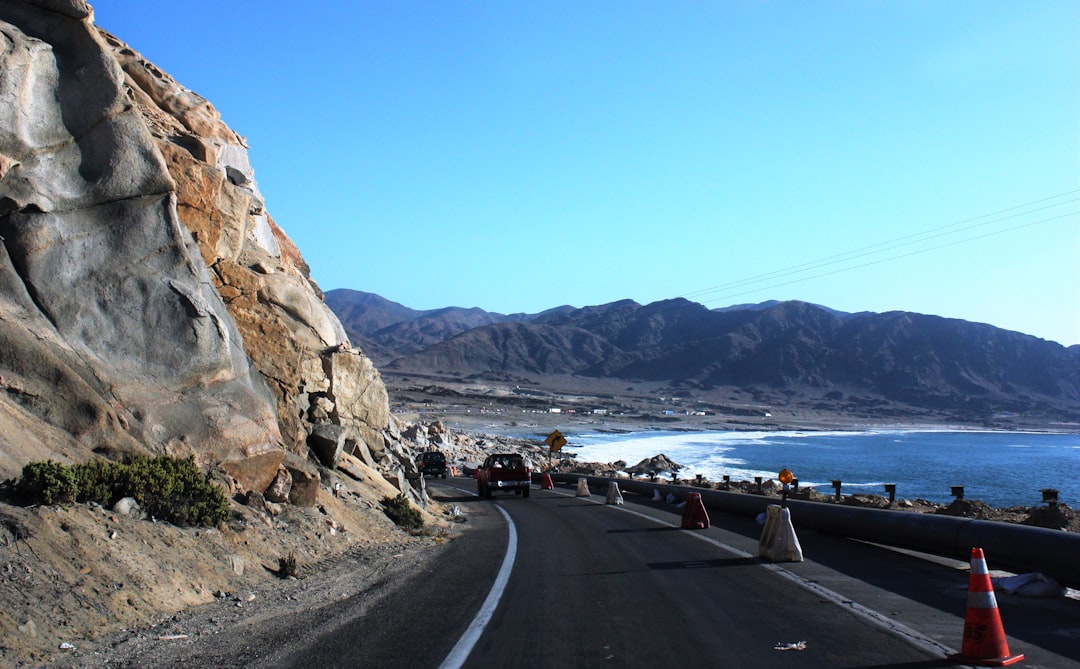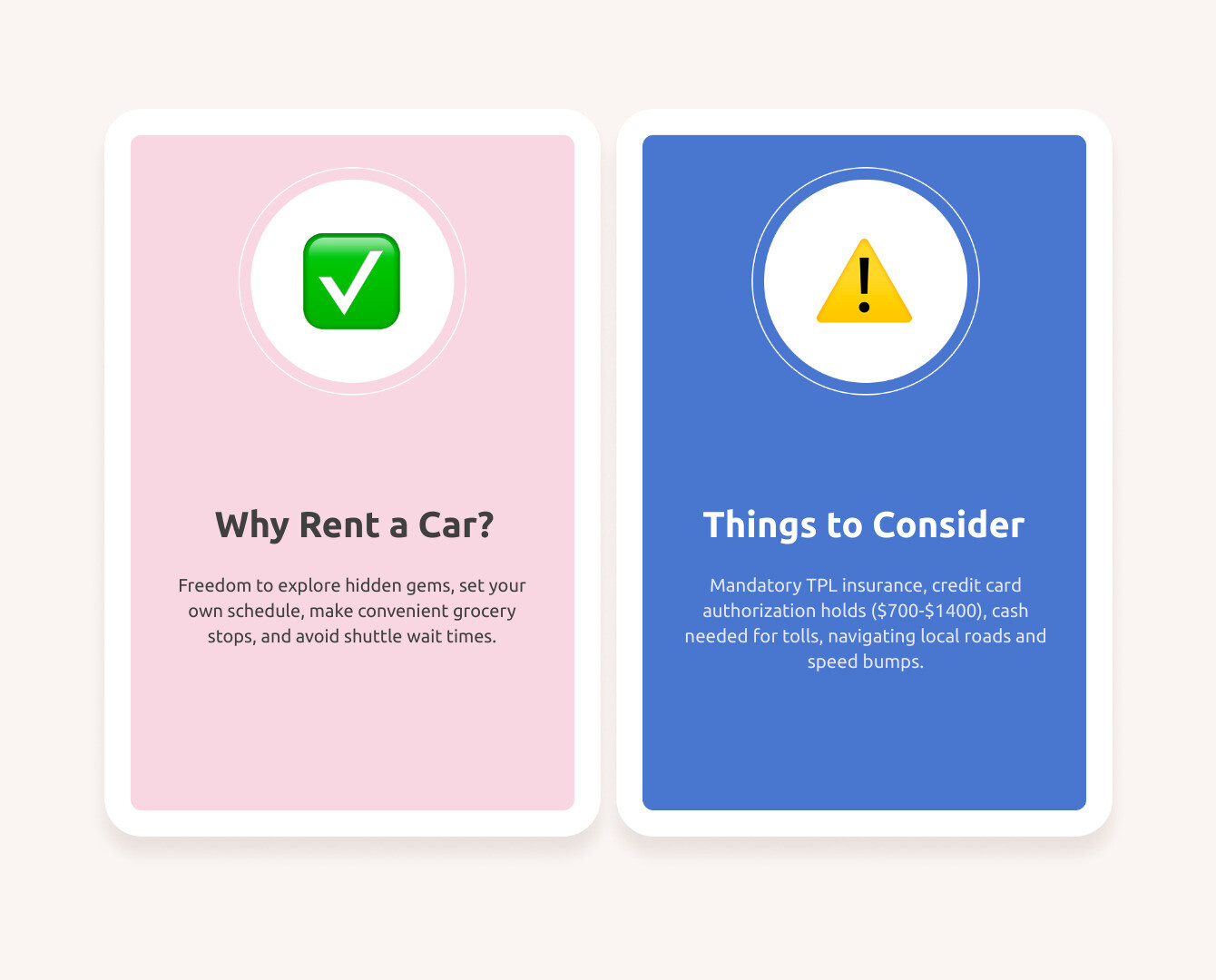Navigating Your Cabo Adventure: Is a Rental Car Right for You?
Cabo car rentals give visitors the freedom to explore Los Cabos at their own pace. However, choosing the right option requires understanding costs, insurance, and local driving conditions.
Quick Answer: Key Facts About Cabo Car Rentals
- Average Cost: $51/day year-round, with rates as low as $12/day in September and up to $33/day in December.
- Minimum Age: 21 years old (drivers 21-24 may pay additional fees).
- Requirements: Valid driver’s license, passport, and a credit card in the renter’s name.
- Mandatory Insurance: Third-Party Liability (TPL) insurance is required by Mexican law.
- Popular Vehicle Types: Full-size SUVs, compact sedans, minivans, and jeeps.
- Major Providers: A mix of local and international companies are available at the airport and in town.
Planning a trip to Los Cabos means balancing adventure with practicality. The region’s stunning beaches and the vibrant towns of Cabo San Lucas and San Jose del Cabo are well-connected. Deciding whether to rent a car involves weighing several factors.
Booking your rental car about 65 days in advance can secure below-average prices. While the most popular choice is a full-size vehicle, many visitors find deals as low as $24 per day for compact cars.
A rental car provides independence to explore hidden gems like Todos Santos or the peaceful beaches of the East Cape. You can make grocery stops and travel on your own schedule. However, car rentals in Mexico have complexities. Mexican insurance requirements differ from U.S. and Canadian policies, and Third-Party Liability insurance is mandatory. Credit card holds can be substantial, and toll roads require cash. Navigating speed bumps (topes) and Spanish-only traffic signs also takes adjustment.
Your Complete Guide to Cabo Car Rentals
Choosing to rent a car in Los Cabos opens up incredible possibilities. You can find everything from the vibrant energy of Cabo San Lucas to the relaxed atmosphere of San Jose del Cabo on your own timeline. To make the most of your experience, you’ll need to understand your vehicle options, pricing, and the rental process.
Choosing Your Ride & Understanding Costs
Your first decision is choosing the right vehicle. Compact cars are fuel-efficient and affordable, perfect for paved roads and city streets. Mid-sized sedans offer more comfort and space. SUVs are very popular, ideal for handling diverse terrains and accommodating more passengers and luggage. For larger groups, vans and minivans provide ample seating and storage.
The average cost for a rental car in Cabo San Lucas is around $51 per day, but timing is everything. September is the most budget-friendly month, with average rates dropping to just $12 per day. In contrast, December sees prices jump to around $33 per day due to holiday demand. We recommend booking about 65 days in advance for the best prices and vehicle selection.
Beyond the daily rate, watch for other costs. Most companies have a full-to-full refueling policy; return the car with less than a full tank and you’ll pay premium prices for fuel. Also, be prepared for a credit card authorization hold of $700 to $1,400 USD, plus the rental cost. This security deposit is released upon the car’s safe return, but you must have sufficient available credit.
The Nitty-Gritty: Insurance, Requirements & Booking for Cabo Car Rentals
Insurance is one of the most important things to understand. Third-Party Liability (TPL) insurance is mandatory by law in Mexico. This is not optional. TPL covers damages you might cause to others. Critically, most foreign insurance policies from the U.S. or Canada are not valid for liability coverage in Mexico. You must purchase TPL from the rental company.
Optional coverages are also available. Collision Damage Waiver (CDW) and Theft Protection (TP) cover the rental car itself. Personal Accident Insurance (PAI) covers medical expenses for you and your passengers. Roadside Assistance (RAP) covers issues like flat tires and lockouts.
Many travelers ask about using credit card insurance. While some cards offer rental car benefits, they typically only cover collision damage (CDW) and do not satisfy Mexico’s mandatory TPL requirement. Always check with your credit card provider about their specific terms for international rentals before you travel.
| Coverage Type | Mandatory in Mexico? | Typically Covers | Where to Get It |
|---|---|---|---|
| Third-Party Liability (TPL) | Yes | Damages/injuries to others or their property | Rental company (required), or valid Mexican policy |
| Collision Damage Waiver (CDW) | No | Damages to the rental car | Rental company, or credit card benefits (check terms) |
| Theft Protection (TP) | No | Theft of the rental car | Rental company, or credit card benefits (check terms) |
| Personal Accident Insurance (PAI) | No | Medical expenses for driver/passengers | Rental company, or personal travel/health insurance |
| Roadside Assistance (RAP) | No | Towing, flat tires, lockouts, jumpstarts, fuel delivery | Rental company |
To rent a car in Los Cabos, you must meet certain requirements. The minimum age is typically 21, though drivers 21-24 may face a surcharge. You will need a valid driver’s license from your home country. If your license isn’t in the Roman alphabet, an International Driving Permit (IDP) is recommended. You’ll also need a valid passport and a major credit card in the renter’s name.
Airport vs. Downtown: Pickup Location Pros & Cons
Your pickup location affects both convenience and cost. Los Cabos International Airport (SJD) offers maximum convenience. You can land, get your keys, and be on your way. This immediacy is great for families or those with lots of luggage, but airport rentals can be slightly more expensive due to fees and taxes.
Downtown rental locations in Cabo San Lucas or San Jose del Cabo can offer better rates. The catch is you’ll need transportation from the airport to the rental office. Our private transfer or shared shuttle services can get you there comfortably. This option works well if you’re willing to take a short ride to save some money.
For more tips on navigating the airport, check out our Los Cabos Airport Arrival and Departure Tips.
Driving in Los Cabos: Tips, Day Trips & Alternatives
Having a rental car in Los Cabos is great for exploration, but it’s wise to understand local driving conditions and know when other transportation options might be better for your trip.
Best Practices for Navigating Local Roads
Driving in Los Cabos is generally straightforward. Motorists drive on the right side of the road. However, a few local quirks require attention.
- Road Signs: Most traffic signs are in Spanish. It’s helpful to familiarize yourself with common Mexican road signs before you arrive.
- Speed Bumps (Topes): “Topes” are everywhere and can be abrupt. They are not always clearly marked, so keep your eyes open and slow down to avoid damaging the car.
- Toll Roads (Cuota): The main highways, like the one connecting the airport to Cabo San Lucas, are often toll roads. These “cuota” routes are well-maintained. Always carry cash in Mexican pesos or U.S. dollars for tolls, as credit cards are not always accepted.
- Road Conditions: Main highways are in excellent shape. Secondary roads to remote beaches can be unpaved. If you plan to explore off the beaten path, an SUV is a good choice.
- Traffic & Parking: Roads can get crowded during peak seasons. To avoid congestion, try not to drive into town during the morning rush (8-10 a.m.). Parking in downtown Cabo San Lucas can also be challenging, so look for designated lots.
Scenic Drives: Must-Do Day Trips from Cabo
One of the biggest perks of a rental car is the freedom to take day trips. The Baja California Sur peninsula is filled with charming towns and beautiful landscapes.
- Todos Santos: About an hour north of Cabo San Lucas, this “Pueblo Mágico” (Magic Town) is known for its art galleries and the iconic Hotel California.
- La Paz: The state capital, located two hours north, offers a beautiful waterfront promenade (malecón) and calm, turquoise waters perfect for swimming.
- The East Cape: For an adventurous trip, towns like Los Barriles offer world-class fishing and kitesurfing in a rugged, authentic setting. An SUV is recommended for the less-developed roads.
- Cabo Pulmo National Park: This protected marine sanctuary is home to a living coral reef, making it a paradise for snorkelers and divers. The road is mostly unpaved, so a sturdy vehicle is essential.
- Cerritos Beach: A popular surf spot just south of Todos Santos that’s great for all skill levels.
Is a Rental Car Your Only Option? Exploring Alternatives to Cabo Car Rentals
While a rental car offers flexibility, it’s not always the best choice. Depending on your plans, alternatives like our private transportation and shared shuttle services can be a better fit.
Private Transportation is a stress-free, comfortable alternative perfect for families and groups. When you book a private transfer, your bilingual driver and vehicle are waiting for you at the airport. We monitor your flight, so we’re there even if you’re delayed. Service is door-to-door, directly to your resort or villa, and we can access private, gated communities. Other benefits include:
- Grocery Stops: We can arrange a stop on the way to your accommodation.
- Complimentary Drinks: Our private vehicles include complimentary beer or water for each passenger.
- Child Safety: We provide child safety seats upon request.
Shared Shuttles are the most economical choice for budget-conscious travelers, with seats costing between $13 and $40 USD per person. It’s a great way to get from the airport to your resort. Key things to know are:
- Wait Times: Shuttles depart after coordinating with other passengers, so there may be a wait of 15 minutes to an hour.
- Multiple Stops: Shuttles make an average of 2-4 stops to drop off other guests.
- Restrictions: Shared shuttles cannot make grocery stops, and child seats are not permitted. They also cannot enter gated communities but can drop you at the security gate.
Which option is right for you?
- A rental car is best if you plan multiple day trips and want complete independence.
- Private transportation is ideal for families, groups, or anyone prioritizing comfort, direct service, and convenience like grocery stops or child seats.
- A shared shuttle works well for solo travelers or couples on a budget who are flexible with time and don’t need extra stops.
Booking your transportation in advance is always recommended to guarantee availability. You can cancel any shuttle or private transfer up to 72 hours before your service for a full refund, minus a $5 USD processing fee.






